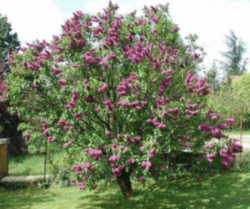New York State Bush
Lilac Bush

(Syringa vulgaris)
Adopted on August 16, 2006.
The lilac bush, (Syringa vulgaris,) was designated the official state bush of New York state in 2006. The lilac is an ornamental shrub with showy, aromatic blooms in early spring. Lilacs have a scent stronger than roses that carries quite a distance. There are over 1,000 varieties of lilacs in several colors including white and pink (the most popular colors are lilac and purple). A lilac bush can live for hundreds of years.
Originally from Europe and Asia, lilacs date back to the 1750's in America - they were planted in our first botanical gardens and both George Washington and Thomas Jefferson grew lilacs in their gardens. New Hampshire recognizes the lilac blossom as the official state flower.
New York State Bush: Lilac Bush

Syringa vulgaris (lilac or common lilac) is a species of flowering plant in the olive family Oleaceae, native to the Balkan Peninsula, where it grows on rocky hills. This species is widely cultivated as an ornamental and has been naturalized in other parts of Europe (UK, France, Germany, Italy, etc.) as well as much of North America. It is not regarded as an aggressive species, found in the wild in widely scattered sites, usually in the vicinity of past or present human habitations
Culture
Easily grown in average, medium moisture, well-drained soil in full sun. Tolerates light shade, but best bloom is in full sun. Intolerant of full shade. Prefers moist, fertile, organically rich, slightly acidic to slightly alkaline soils with good drainage. Avoid soggy soils. Needs good air circulation. Prune as needed immediately after flowering. To the extent practicable, promptly remove faded flower panicles before seed set. Best grown in cool summer climates. Not recommended for planting in the hot and humid conditions of the deep South in USDA Zones 8-9. Promptly remove root suckers, particularly on grafted plants, to maintain plant appearance and prevent unwanted colonial spread. Propagate by cuttings in spring.
Characteristics
Syringa vulgaris, commonly known as common lilac, is an upright, multi-stemmed, suckering, deciduous shrub in the olive family that typically
matures to 12-16' (20') tall with a spread to 8-12' (15') wide. It is native to open woodlands, rocky hills and scrubby areas in southeastern Europe,
but has been widely cultivated throughout Europe (beginning in the late 1500s) and North America (brought over by colonists in the early 1600s). It
is particularly noted for its mid to late spring (May) bloom of very fragrant, tubular, 4-lobed, lilac to purple flowers (each to 1/3"long) which
bloom in large conical to narrow-pyramidal panicles (to 6-8"long). Flowers give way to loose clusters of smooth, brown, flattened, dehiscent seed
capsules (each to 3/ 4"long) which persist into winter if not removed. Glaucous, opposite, pointed-ovate to heart-shaped leaves (2-5"long)
are dark gray-green to blue green. No fall color. Bark is gray to gray-brown.
Numerous cultivars have been introduced over time in both single and double-flowered forms. Cultivars extend the range of available flower colors to
include shades of white, cream, rose, magenta, pinkish-purple, lavender and purple.
Common lilac has few post-bloom ornamental features of note. Significant post-bloom limitations include often leggy shrub form, foliage depreciation
from powdery mildew, non-showy fruits and absence of fall foliage color. These shrubs are in large part grown for their flowers and fragrance. It is
the State flower of New Hampshire even though it is not native to the U. S.
Genus name comes from the Greek word syrinx meaning tube or pipe in reference to the pith-filled but easily-hollowed stems of some genus plants. Stems
were once used for pipes. In the same vein, Syrax was a nymph from Greek mythology who was metamorphosed into a hollow willow reed in order to escape
the amorous advances of Pan, god of the fields and forests, in further reference to the hollow stems of some genus plants.
Specific epithet from Latin means common.
'Sensation' is an upright, deciduous shrub which grows 8-15' tall. Deep purple to wine red, sweetly fragrant, single flowers with white edges are arranged
in dense, pyramidal, terminal clusters (panicles) which cover this shrub in late April to early May (St. Louis).
Leaf: Opposite, simple, broadly ovate, 2 to 4 inches long, 1 1/2 to 3 inches wide, heart-shaped, entire, dark green to bluish green
above, lighter below.
Flower: Light purple, pink or even white (cultivar dependent), fragrant, flowers in terminal clusters 4 to 7 inches long, appearing
in late spring.
Fruit: Dry, brown capsules, 1/2 inch long.
Twig: Stout, angled (almost 4 sided) or ridged, lustrous brown, glabrous, numerous raised lenticels; leaf scars raised, crescent-shaped;
buds large, green but turning purple in the winter.
Bark: Gray to gray-brown, smooth but becoming finely shreddy when large.
Form: A multi-stemmed, suckering, tall shrub reaching up to 15 feet in height.
New York Law
The law designating the liac bush as the official New York state bush is found in the New York State Consolidated Laws, STL, Article 6, Section 87.
STL - State
ARTICLE 6 - ARMS AND GREAT SEAL OF STATE
SECTION 87
§ 87. State bush. The liac bush (Syringa vulgaris) shall be the official bush of the state.
* NB There are 2 § 87's
Taxonomic Hierarchy: Lilac Bush
Kingdom: Plantae - Plants
Subkingdom: Tracheobionta - Vascular plants
Superdivision: Spermatophyta - Seed plants
Division: Magnoliophyta - Flowering plants
Class: Magnoliopsida - Dicotyledons
Subclass: Asteridae
Order: Scrophulariales
Family: Oleaceae - Olive family
Genus: Syringa L. - lilac
Species: Syringa vulgaris L. - common lilac








